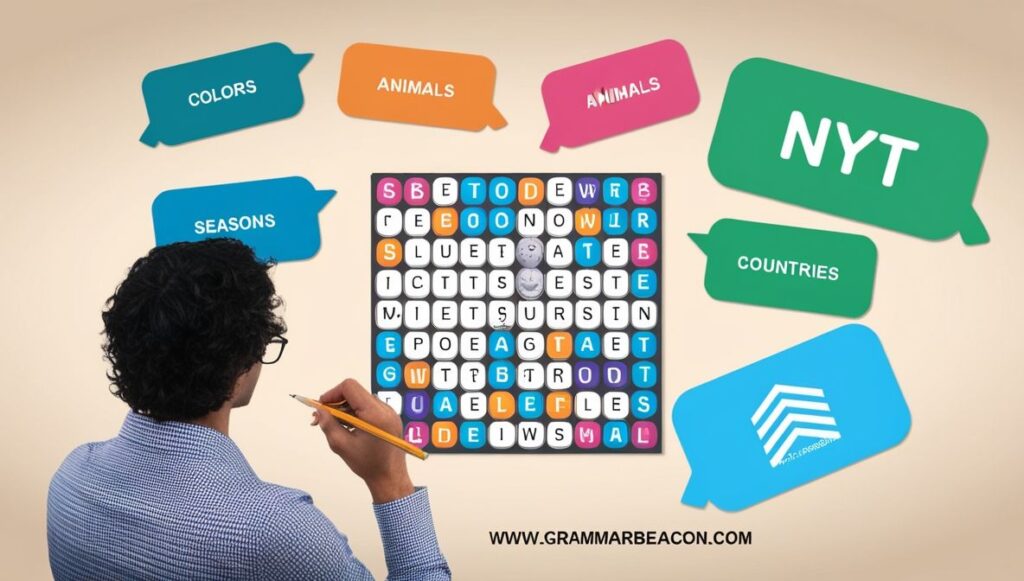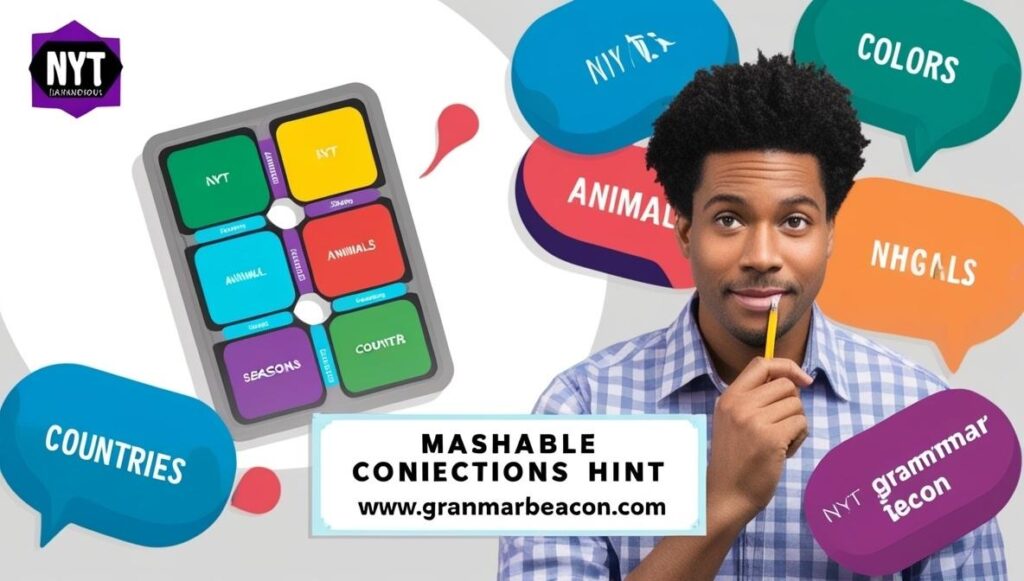Have you ever loved the thrill of discovering hidden connections? That ‘aha’ moment when everything clicks? The New York Times Connections puzzle gives you 16 words and asks: can you sort them into four word associations? It’s concise but packs a punch. With word association, pattern recognition, and strategic thinking, every day feels like a mental scavenger hunt.
Because puzzles like this hit a sweet spot they’re quick to start, hard to master, and endlessly satisfying. Whether you’re a casual fan or a hardcore puzzle geek, honing your puzzle solving skills pays off in clever thinking and confident reasoning. Let’s crack it!
How the NYT Connections Puzzle Works

Game rules
- You see a 4×4 puzzle grid of 16 words.
- Your goal: group them into four thematic puzzle categories, each with four words.
- Tap or click words to form groups wrong picks penalize, so choose wisely.
Hint structure
NYT gives three levels of hint categories:
- Initial clue broad hint
- Intermediate clue narrows it down
- Final clue tells you exactly the connection
Scoring
Solve all four groups. Each mistake costs a penalty point. Faster solves yield bragging rights.
Also included in our list for: What’s the Plural of Iris?
All Types of Connections: Examples Inside
NYT keeps things fresh by pulling themes from all corners. Here are some common themes and original examples:
| Connection Type | Example Words | Explanation |
| Pop culture | Thriller, Avatar, Rocky, Jaws | Movies with iconic soundtracks or directors |
| Homophones | Mail, Male, Knight, Night | Sounds the same, spelled differently |
| Idioms | Cold shoulder, Out cold, Shoulder chip, Cold feet | Phrases using “cold” or “shoulder” |
| Historical figures | Lincoln, Mandela, Gandhi, Churchill | Famous world leaders |
| Foods | Brie, Gouda, Edam, Camembert | Types of cheese |
| Animals | Tiger, Whale, Swan, Lynx | Species with graceful or powerful traits |
| Colors | Red, Blue, Cyan, Magenta | Primary vs. tertiary colors |
| Countries | Canada, Japan, France, Brazil | Diverse nations around the globe |
| Seasons | Spring, Summer, Fall, Winter | Classic time divisions |
Pro tip: Don’t assume the first four you see are the first category NYT mixes them up.
Understanding Today’s Puzzle Trends
NYT daily puzzle update shows a growing trend:
- More pop culture recently think blockbuster films or hit songs.
- Homophones and wordplay keep making a comeback.
- Puzzles now include hybrid categories e.g., colors that match food names.
Today’s categories have shifted toward these trends:
- Hybrid Connections: Combining different types, like a celebrity and their hit song.
- Seasonal Themes: Summer vibes show up in May and June. In contrast, winter words peak in December.
- Pop Culture-heavy rounds make for fast guesses but they also require current knowledge.
Staying sharp means tracking these shifts. Track recent puzzle breakdowns on puzzle forums to spot emerging patterns.
This is also on our list of: Luis’ or Luis’s Possessives
How to Decode Clues Like a Pro
Start strong, go smart:
1. Scan and cluster
Quickly glance at all 16 words and cluster mentally by theme (e.g., foods, animals, colors).
2. Pick the obvious group
Nail that first four: say “Brie, Humus, Sushi, Tacos” = Foods. Confirm and clear them.
3. Use exclusion
Take away solved words. Analyze remaining 12 for patterns like homophones or idioms.
4. Watch for word lengths
Consonance and clue structure matter. For instance, four six-letter words might be countries.
5. Track cross-group overlap
If “Spring” begins to fit a seasonal group with other words, go for it but confirm it’s complete before locking it in.
6. Use hint categories
- Initial clue: paves the way
- Intermediate clue: confirms or narrows it
- Final clue: use it carefully to avoid penalties
7. Avoid penalty picks
One wrong choice costs you. Be 80% sure before selecting.
8. Time your risk
If you’re stuck on the third category, use hints strategically and don’t gamble.
Comparing Hint Providers: Which Site Helps You Best?
Here’s a comparison table of top hint providers:
| Feature | Mashable hints | TechRadar puzzle guide | CNET Connections Hint | Reddit (r/NYTConnections) |
| Hint timing | Scheduled daily at 4 p.m. ET | Early morning release | Same day at noon | Real time from solvers |
| Depth of explanations | Deep insights & examples | Moderate detail | Brief & to the point | Variable in depth solvers |
| Pop culture awareness | High (Memes, current shows) | Medium | Medium | Very high—community-driven |
| Visual aid (tables, etc.) | Often includes graphics | Some visuals | Text-focused | Rarely but occasionally charts |
| Community interaction | Comments allowed | Minimal | None | Very interactive, helpful |
Pros & Cons:
Mashable
- ✅ Great visuals
- ✅ Fresh pop culture
- ❌ Might spoil all groups
TechRadar
- ✅ Clear guidance
- ❌ Lacks color or visuals
CNET
- ✅ Concise
- ❌ Minimal extras
- ✅ Interactive, smart solving
- ❌ Sometimes spoilers or slow threads
Pick the right mix for your style. For visual learners, Mashable puzzle guide is gold. If you prefer discussion and insight, r/NYTConnections shines.
The Power of Community: Reddit, Discord & Facebook Groups
Why community matters:
- Collaborative gameplay enhances learning.
- Puzzle discussions boost your critical thinking.
- Feedback helps refine strategies.
Reddit (especially r/NYTConnections)
- Real time chat
- Users share hint categories, strategies, and progress
- Quotes like:
“I spotted the homophone set fast because someone said ‘sounds like two different words’” verbose yet valuable insight.
Discord channels
- Voice discussions and live solving
- Great for instant sharing and celebrating victories
Facebook groups
- Mixed audiences beginners to pros
- Savvy moderators post daily NYT Connections hints early
Join a few to stay sharp, motivated, and part of a wider puzzle community.
Daily Warm Up Exercises
Boost logic, speed, and vocab before diving in:
- Five minute word swirl – List any four words in a random category
- Homophone challenge – Write pairs like “flour/flower”
- Analogy creation – Say “Dog is to puppy as cat is to ”
- Mini connections – Mix four random words, find a link
- Synonym scramble – Pick a word and list 3 synonyms
These drills refine your pattern recognition, vocabulary, and speed all factors that level up your Connections game.

Conclusion
Stepping into the NYT Connections game means joining a daily habit of curiosity, logic, and community. You gain sharper thinking, richer vocabulary, and that unbeatable hit of satisfaction after solving a challenging puzzle.
Whether you lean on Mashable hints, swap strategies over Reddit, or run warm‑ups before playing, you’re giving your brain something fun to chew on. And that’s what puzzles should be.
Dive in, solve smarter, and enjoy the journey because mastering Connections means mastering your own curiosity.
FAQs
Mashable hints include visuals and deeper pop culture insight, while Reddit offers real‑time discussion and alternate viewpoints.
Use the Initial clue early if unsure. Save the Final clue for when you’re stuck and want to avoid a penalty guess.
Absolutely daily warm ups like word swirls, homophone drills, and analogies sharpen logic and boost vocabulary.

James Logan is a seasoned blogger and language enthusiast behind Grammar Beacon. With years of experience in grammar and writing, James shares his expertise through insightful and engaging content. His passion for clear communication and linguistic precision shines in every post, making complex grammar concepts accessible and enjoyable for readers. Follow James for expert advice and tips to refine your writing skills.







